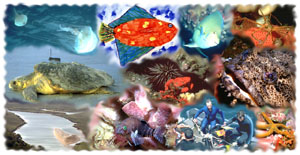|
|
Error processing SSI file |
|
|
|
|
Over 150 species of fish including black sea bass, snapper, grouper and mackerel are attracted by the reef. Larger fish like barracuda and nurse shark ply the fertile waters. Algae and invertebrates grow on the exposed rock surfaces; dominant invertebrates include sponges, barnacles, sea fans, hard coral, sea stars, crabs, lobsters, snails, and shrimp. These conditions create an ideal habitat for the threatened loggerhead sea turtles.
Following close behind the schools of fish are the many sport fishing and diving enthusiasts who have made Gray's Reef one of the most popular recreation areas along the Georgia coast.
Gray's Reef Sanctuary is also an important part of the only known winter calving ground for the highly endangered North Atlantic right whale. The sanctuary has joined with other partners in learning more about this vulnerable marine mammal. One project enlisted the help of The New England Aquarium and NOAA Fisheries to initiate a research tagging program that gives biologists a rare opportunity to study the nation's most endangered large whale species. Once favored as the "right whale" to whalers, today the greatest threats to their existence are ship strikes, fishing nets, and habitat loss. Current estimates indicate that fewer than 350 remain in the North Atlantic Ocean. You can learn more about the North Atlantic Right Whale by visiting http://www.rightwhale.noaa.gov.
The Gray's Reef photo collection contains images which portray only a small portion of the living and physical resources of the sanctuary. It also includes photographs that depict some of the major uses of the sanctuary. For a more detailed description of the marvels of the sanctuary, please visit the Gray's Reef National Marine Sanctuary Web site.
The
Collection
The Living Sanctuary presents 17 photos depicting fish, turtles, crustaceans, and invertebrates. Among these images are sharks, angelfish, corals, sponges, baracuda, jellyfish and anemone to name just a few.
Habitats presents 9 photos depicting the various marine and nearshore habitats making up the sanctuary. Included in this section you will find rivers, coral reefs, life on the ocean surface and other representatives of the diverse habitat making up the sancutary.
People and the Sanctuary presents 8 images depicting a few ways that human beings use the sanctuary and its adjacent areas. You will see people diving, counting fish for a fish survey, and monitoring the movements of sea turtles.
The Sustainable Seas Expeditions photos for the July - August 1999 expedition are unavailable.
The Kids Gallery for the Gray's Reef National Marine Sanctuary contains 8 images which represent the sanctuary through the eyes of local school children.

